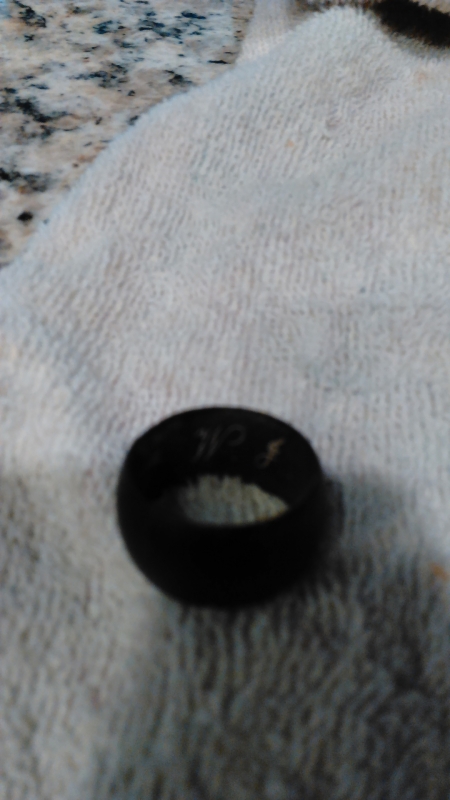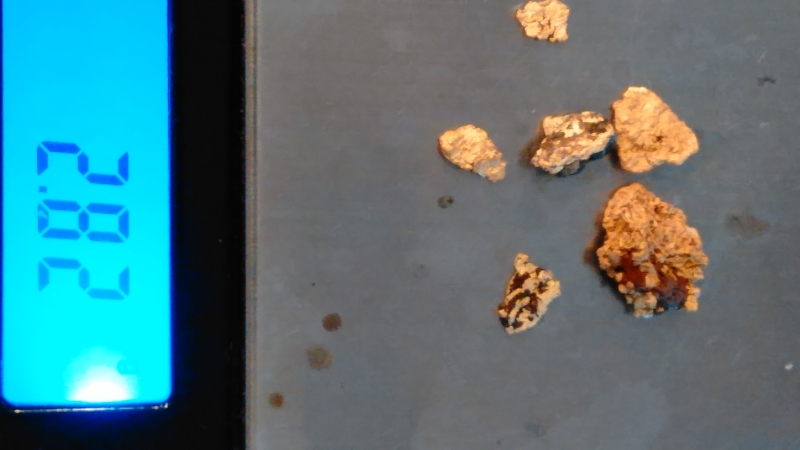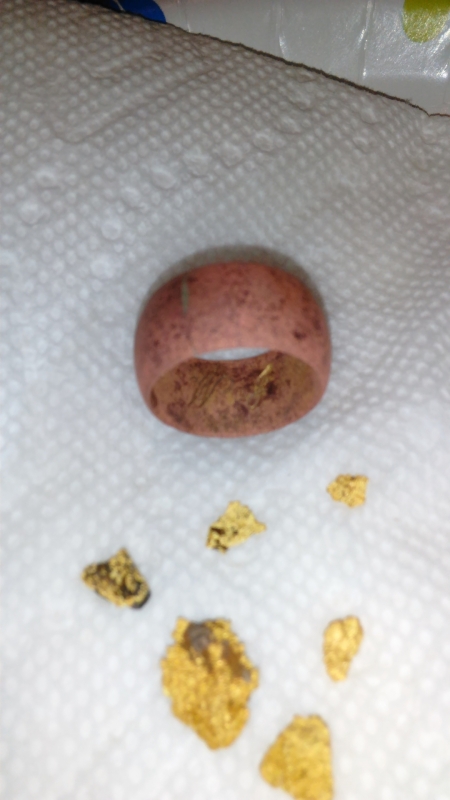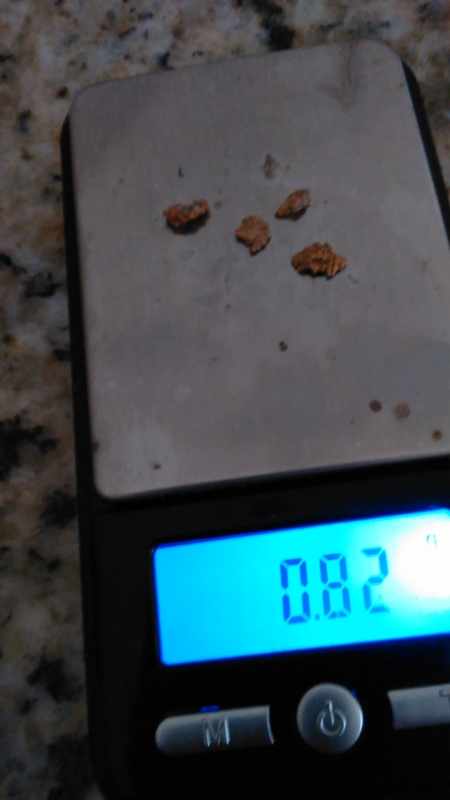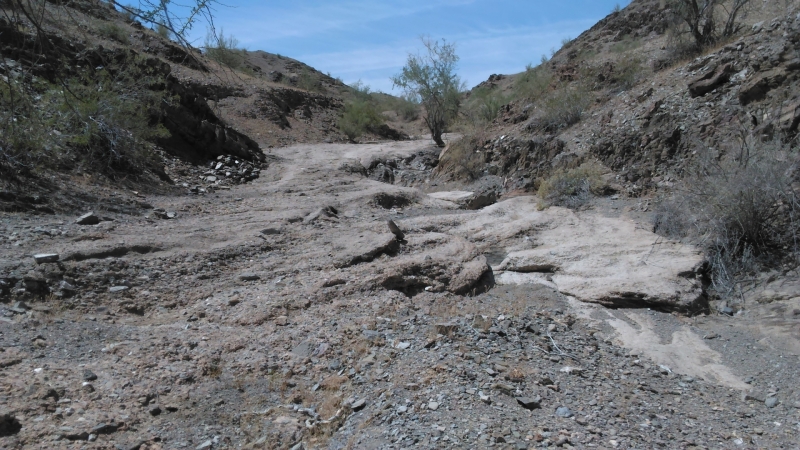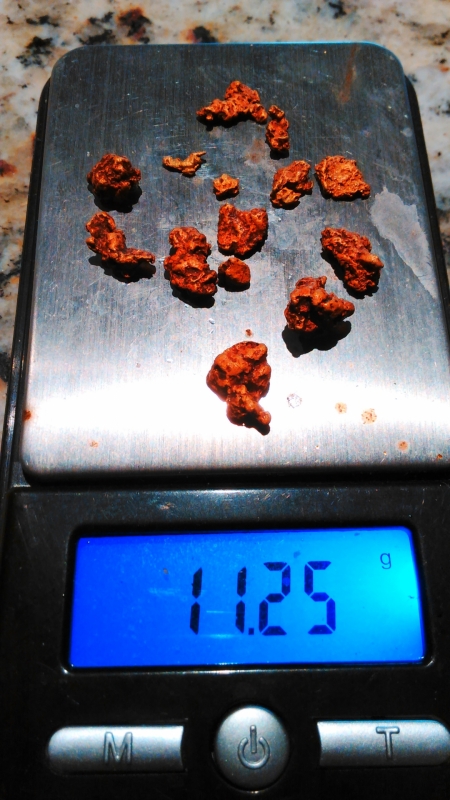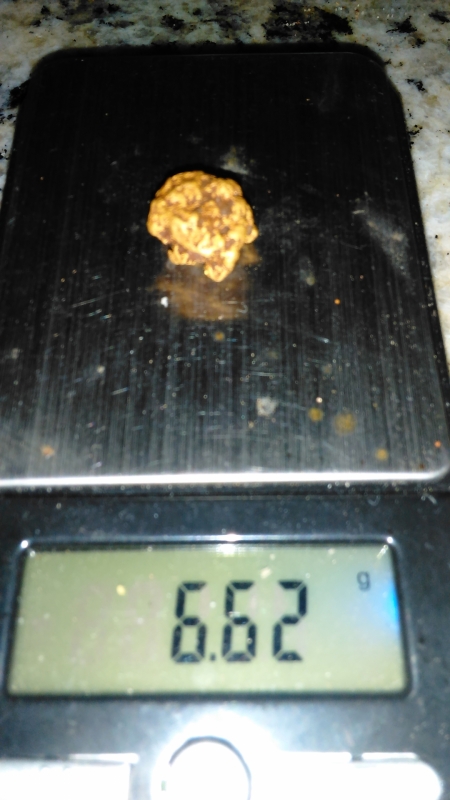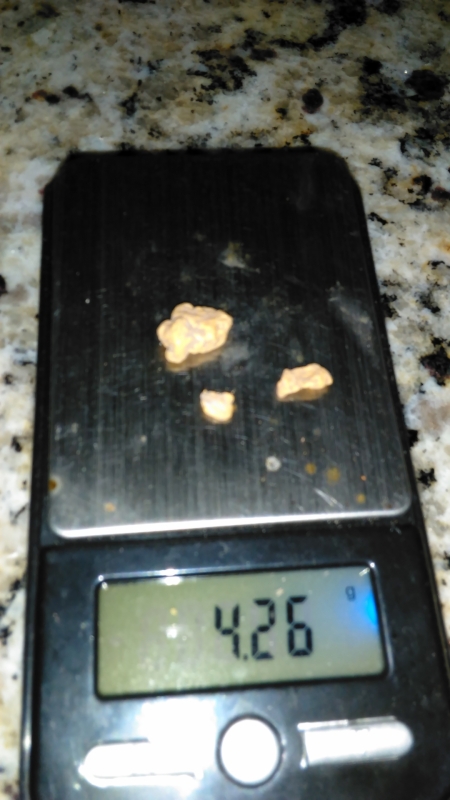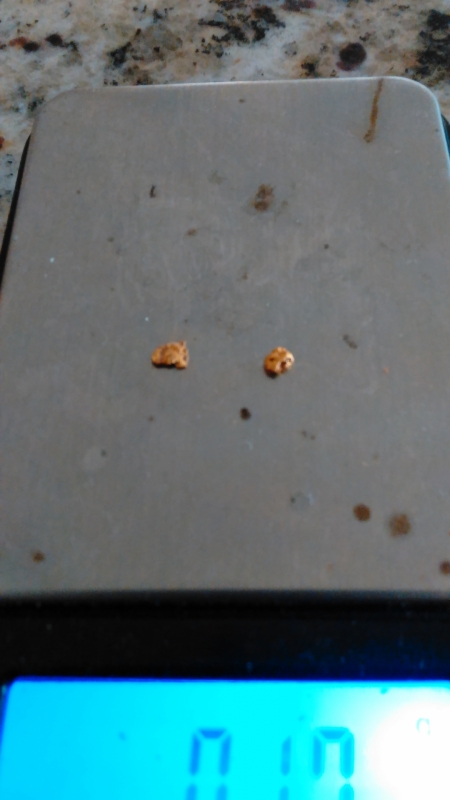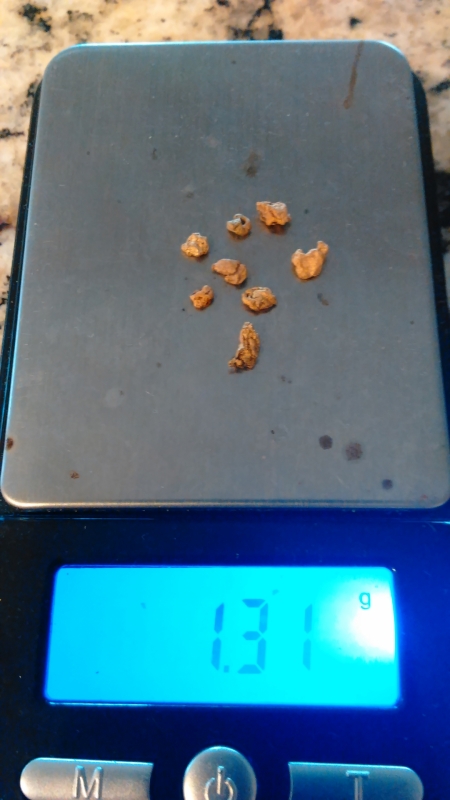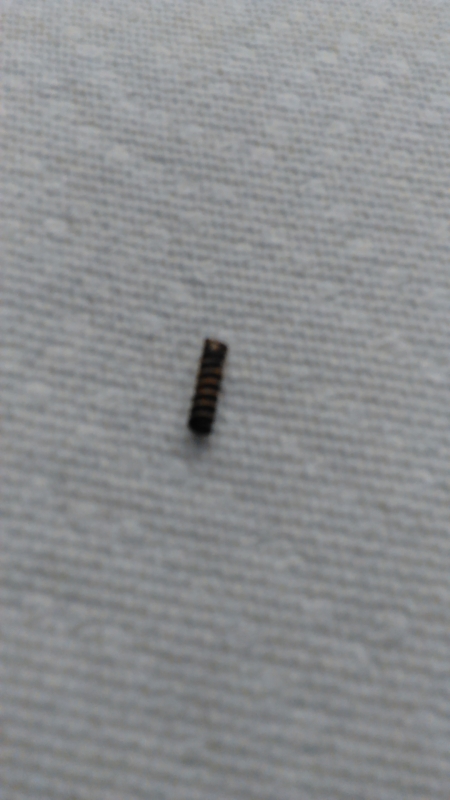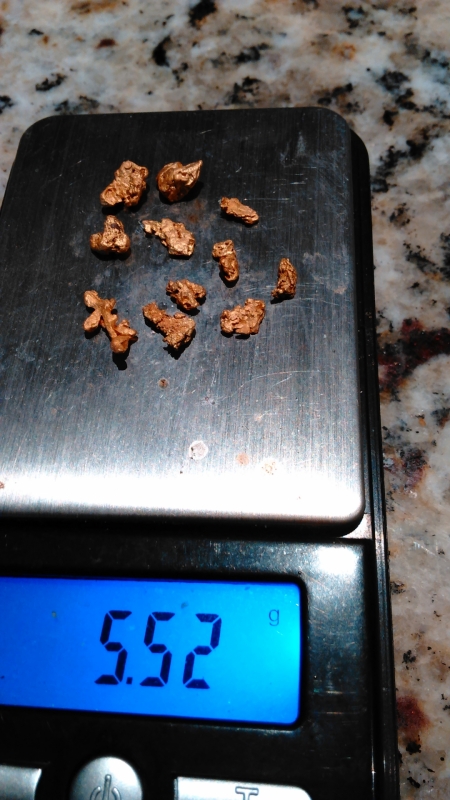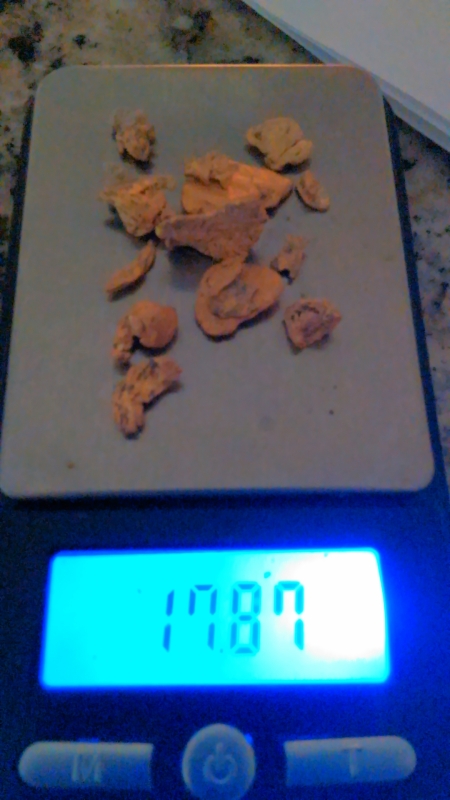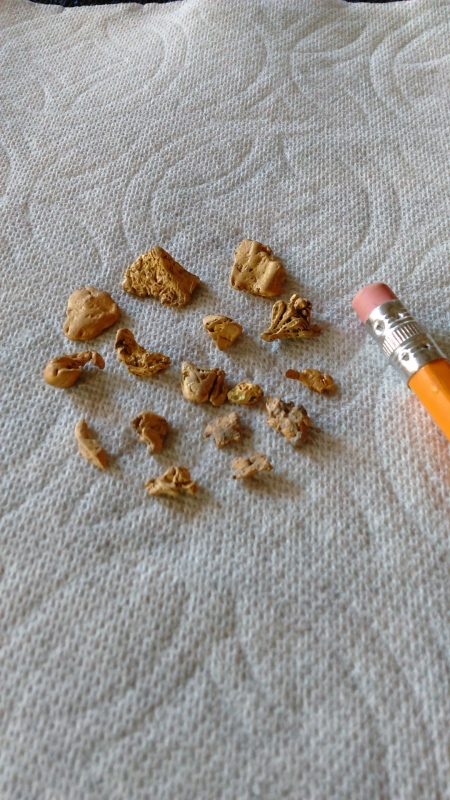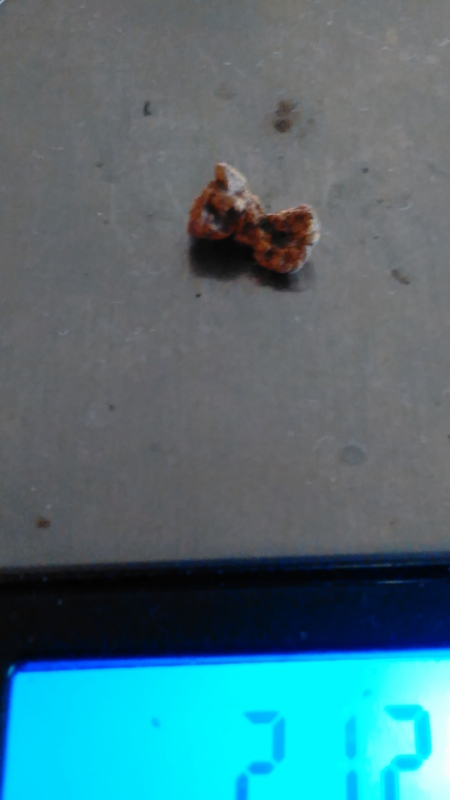
Condor
Full Member-
Posts
434 -
Joined
-
Last visited
Content Type
Forums
Detector Prospector Home
Detector Database
Downloads
Everything posted by Condor
-
I got back out with the Deus HF today. I pushed into an area I have strenuously avoided with non-discriminating detectors because it is littered with 1940's vintage rusted out cans and ferrous junk. I ran the Deus with the same settings as on my 2nd go. I picked up the 2 biggest nuggets right next to an old pile of cans. The GPZ would have been howling with just proximity to that much junk. I wondered how hot the 9" round HF coil would be on small stuff. I got my answer, the smallest was .07 gram wedged in a tiny bedrock crack. The signal was unmistakable, although I was doubting it until I busted out the crack. The biggest surprise was a ring down in a bedrock pocket. I dismissed it as a piece of plumbing copper expansion collar until I looked closely and saw engraved initials and a stamp indicating 14k. Perhaps it was originally plated with 14k gold, but after a quick soak in CLR, it sure looks like copper to me. I'm really liking the Deus for this kind of detecting. Shallow bedrock, littered with old junk. The discrimination is spot on. I dug a number of targets just to check. Iffy targets like modern nails will bust through the discrimination if you don't tickle the edges and let the software do it's stuff. I still dug a lot of non-ferrous junk like copper wire and lead bullet fragments, but tolerable at these depths. Deus = good times in trashy ground
-
Hey Fred, I wheeled and dealed using some of my gold to find a replacement 7000. I had actually found almost 9 oz of gold with the original 7000, so it in essence paid for itself. Now I'm starting over, sad face, but glad face that I'm back in the saddle. I'll looking to head up North when the heat runs me out of Yuma. Rob is spot on, in a trashy area the Deus will excel on shallow gold. Jasong, This is my 2nd time out with the Deus and I purposely left the 7000 behind so that I would stick to the Deus and give it a decent workout. I think you will be pleasantly surprised with the Deus. I sold my GB II, my GBPro and now have a buyer for my 2300, the Deus is filling the niche as a backup to my 7000 and go to for shallow bedrock. It's feather light, collapses down for packing and wireless to boot. I would really like to give it a go in the old hydraulic pits up north. It's not going to help on bullets and lead fragments, but on square nails it should really give me an advantage. I just don't have the fortitude to dig the trash that Steve H and others are willing to endure.
-
I took the XP Deus, with new HF round coil, out for another go. I had detected this bedrock desert wash a few years ago with the Gold Bug II and did pretty well. Last year I went over it with the SDC 2300, but it was overkill. The ground is not hot enough, nor deep enough, to justify "pulse induction" and there was a lot of iron trash. To reach this wash takes a pretty good hike over rough terrain. Carrying the Deus strapped to my pack was a breeze and I deliberately left my 7000 at home. The temps reached a little over 100 here in Sunny Yuma, so pack weight starts to matter. As you can see in the photo this is old conglomerate type false bedrock wash. There are sections of deeper gravels, but the amount of old iron trash really makes it unattractive for the Z 7000. I started out in the Deus standard V4 Gold Program. It worked fine, but I really needed some discrimination to handle the nails and fragments of old rusted out cans. I switched to the V4 standard "Fast" program only because I had used it to hunt a few parks. With the "Fast", I took the discrimination down to 4, and lowered to Reactivity to 2, Sens to 85, running in the 54 KHZ mode. The machine ran like a dream. Iron trash basically grunted and clicked in the discrimination. Larger iron trash busted through the discrimination, but was still recognizable with decent coil control. The little pickers I found barely registered on the "horseshoe" screen and never gave a VID signature. They were however, unmistakable audio target signals. I should have tried the XY screen, but forgot all about it. None of these nuggets was any deeper than a couple inches, so in essence any competent prospecting detector would have found them. I did check one target in the 22 KHZ mode and while recognizable, it was nowhere near as definite as the 54 KHZ. The 9" round coil at 54KHZ is plenty hot enough for small gold, my smallest was .12 gram. In retrospect I should have waited for the elliptical to make pinpointing and recovery a little less cumbersome. I detected for about 2 hrs before the heat became unbearable. I have a couple short videos on my smartphone, but I'm too computer illiterate to edit and post. I'll try to get my son to fix them and put them up. I am very happy with the XP Deus, shout out thanks to Rob's Detectors. As the other Steve has observed, the Deus in theory replaces 2 detectors with just one. For me, it is now a very competent shallow gold prospecting detector in addition to its superb coin and relic hunting origin. It more than meets my expectations and certainly has a place in my detecting arsenal.
-
I took the Deus out for a test run with the brand new 9" round HF coil. I've been a dedicated GPZ user so naturally anything less is bound to seem anemic. I ran the Deus over some fairly mild ground here in Sunny Yuma for about 3 hrs this morning. I started with the standard V4 Goldfield program in the 58 khz and the unit ran really smooth. I went over some ground where the Z had found some shallow tiny bits of gold a few months ago. No Joy, but I can't rule out operator error. I took along a .3 gram test nugget that tested well in air tests at home. Of course we all know how reliable air testing can be. My limited testing left me slightly underwhelmed. At 1.5 inches in the ground, the coil will not pick up the test piece on either lateral edges of the coil. That was not unexpected with the Double D coil, but a little disappointing. The coil will pick up the test piece as soon as it crosses the center line of the coil windings, with the loudest signal practically dead center. The front edge of the coil didn't give a noticeable tone until about 1" into the centerline. I detected all manner of typical goldfield trash and it accurately ID'd most of it. Naturally, lead bullet shards were indistinguishable from gold. Just for grins I switched to the V4 "Hot" program in the same ground at 58 khz. I actually preferred the "Hot" program for a little better tone ID. I moved the Discrimination levels around and tried the -6.4 that's available in the V4. The machine got pretty noisy in the negative Discrim. I played around with the Reactivity levels, but didn't find anything earthshaking. My only real experience with VLF machines was the Gold Bug II which I ran maxed out. The Bug just seemed to have more tone "punch" over tiny gold, but that is just my recollection without any current means to compare. I should have waited for the elliptical coil with the higher frequency like the Bug II. I have one good place with shallow bedrock and a lot of trash that I mean to try next. That should be a better trial for this machine. I really want to like this machine for use in trashy areas that make the Z tiresome. As I was working along a rut in a washed out road I put the coil right over a young rattlesnake apparently out for a little sun. He never buzzed until he got safely under a bush. Just a reminder that springtime is snake season.
-
Hey Steve, I can't remember whether the new HF coils are Double D or Concentric. Now might be a good time to refresh our knowledge base on the relative strengths and weaknesses of DD vs Concentric as they pertain to VLF detectors. As I recall there has been some discussion of this topic scattered in various posts from the past. Can you give us a quick refresher?
-
I'm hoping to do the same thing with the XP Deus once we get the V4 coils. That thing will weigh almost nothing with no control box to add weight and bulk.
-
Paul checked out that ad and ended up buying the detector. It was all very legitimate.
-
For those not following VaNursePaul's Facebook page we had a major theft at my house this morning. Paul had his travel trailer parked in my driveway and our detectors in his Toyota Sequoia parked next to the trailer. Sometime in the wee hours someone stole the Toyota parked right next to the trailer where Paul was sleeping. While we were making a police report they found the Toyota a mile away abandoned, no detectors. The homeowners policy only covers property stolen from my vehicle, not a visitor's vehicle. Paul is checking his renters policy, we're not too confident that the insurance company will make good. You know how it is with insurance, they like those premiums but hate to pay claims. The cops have the serial numbers and we'll be checking craigslist etc.. Anybody hearing of a really good deal on used GPZ let me know.
-
The fact is "Big Red" has been one of the most reliable pieces of equipment I've owned and I'm hard on equipment. My son is the mechanic of the family and he keeps up on the maintenance, me I just drive the crap out of em. I'll go back out later this week and finish my exploration as well as explore the side gullys and hillsides where these nuggets came from. They obviously haven't traveled far from the source, but in this part of AZ alluvial movement is scarce. These nuggets were scattered over nearly 1/2 mile of shallow overburden gully, most of them tucked into the side banks where they haven't moved in many years. I sure wish I had found this before the oldtimers and the VLF detector had gone over them.
-
I took my well worn Polaris 500 out for some exploration in an area that produced gold last year. It had been giving some fuel problems so my son replaced the carburetor and all the fuel and vacuum hoses. It ran fine at home, so I thought it was good to go. I got out to gold country and about 3 miles out from camp it crapped out from a want of fuel. I could get it started and running only if choked. I had no tools with me and decided to walk back to camp and futz with it tomorrow. This morning I packed basic tools and plotted a walking course that would at least take me past some spots that had produced gold last year. After numerous hills and gullys I crossed a gully that had some exposed bedrock so I detoured and noticed signs of digging in a portion of shallow overburden. Sure enough someone had scrapped a signal and given up thinking it was just hot bedrock. I pulled 2 tiny bits of gold out of the same hole and noticed that this particular gully ran NW in the direction I needed to go anyway. As I got further up the gully I could see that the oldtimers had handstacked portions of the gully and someone in the near recent past had detected it, marking target spots with a few stacked rocks. I can only assume they detected it with a VLF because I started finding gold with the Zed in the deeper sections and in the banks under handstacked rocks. After 3 decent nuggets I was stoked and forgot all about that crapped out quad. As always good things come to an end. I got to the end of the gully finding all the gold pictured below. I climbed a high spot to get my bearings and found that the quad was only 1/2 mile away. I got down there and futzed with the quad and found that I could get it going with minimal throttle and choke locked. I poked along until it died again with no sign of restarting. After futzing with the fuel lines a while longer I found the newly installed hose had pulled the fuel return cock fitting out of the carb. I jammed it back in, she started right up and ran like a scalded dog. So, if my quad had not crapped out and forced me to walk over some new ground, I probably would have come home with a few crumbs. Although, I still have high hopes for the area I intended to explore, you just never know. Bye the way I was running the Zed WFO, HY Normal, Sens 20, Volume maxed, Threshold at 1(only because there is no 0). Very quiet ground to work in, minimal trash. The lack of threshold is making some tiny nuggets pop through, maybe its just me, but I'm really liking these settings. Until next time, keep er low and slow.
-
Hey Fred and Brett, Give me a call or text when you are ready to meet up. As far as the lions, a couple years ago I found the carcass of a full grown mountain sheep ram the lion had killed and drug the remains up and into the low branches of a Palo Verde tree. Based on the decomposition and gnaw marks, he had visited the carcass a number of times over a couple weeks. A friend of mine shot one in an archery hunt but lost the trail at twilight. When he resumed the search next morning he found that it had not only died, but another lion was already eating it. I see a fair number of bobcats, but they are really shy and don't weigh more than 20 lbs. I'm a tough old bird, only two things scare me. Women and the Police. One might take all your money, the other take your freedom. It pays to be wary of varmints of all sorts particularly them two legged varieties.
-
I've been running the GPZ, here in Yuma by the Sea, with the In Ear Monitors (Etymotic)+ 75 ohm Impedance adapter + mini stereo amp. My settings have been HY, Normal, Sens of 20, Low Smoothing. The main difference for the past 2 weeks has been full stop minimum Threshold. What I have found is that with more volume from the mini amp, I am hearing everything the machine has to offer with no threshold. Mind you, this is all pretty quiet ground and I really make an effort to avoid the trashy areas. Occasionally I hit the zones of red clay and the machine will heehaw to beat the band. No bueno for these settings. I end up running Difficult in those clay zones. As you can see from the the photos (past 2 mornings), I am finding some really tiny gold. All I can say is without threshold, the Z's background chatter smooths to a hum over tiny gold. They're a bugger to recover and I've walked away from quite a few that I just couldn't get into the scoop. They are obviously so small that it's not worth the effort. The big ones take care of themselves. The 6 gram piece was down about 14 inches on a small terrace above the normal dry desert wash. This system is working for me because with 0 threshold I'm not bombarding my hearing with constant noise. The Ety's are super noise isolating so I am hearing all changes in the background chatter of the Z. The down side is I will have trouble hearing that Lion or rattlesnake if he gets after me. Well, until that becomes a problem I'll stick to what's working.
-
Disclaimer: My testing is not rigorous nor scientific in any way. Individual hearing is highly subjective and what works for me may not work for you. As always your mileage may vary. Detector: Minelab 7000 - HY, Normal, Sens 20, Volume max Earphones: Etymotic 4s 100 ohm impedance Adapter: APureSound 75 ohm impedance 1/4 inch headphone jack conversion to 1/8 earphone jack. Amplifier: FiiO A3 I have always used the Ety earphones in all my previous GPX detectors. Headphones are just too hot and cumbersome for me. The Ety's are top of the line In Ear Monitors with balanced armatures. Ety was primarily a hearing aid manufacturer and got into the earphone market for high end earphones. The 4s cost in the neighborhood of $300.00. Their 3 flange silicone ear piece is super noise isolating, but not particularly comfortable. If you are worried about hearing snakes, cougars, bears and such, you won't like this much noise isolation. Until I went out with Lucky Lundy I was very happy with using the WM12 external speaker for all my detecting. But after seeing his results with really good headphones, I was convinced I was missing some of the super faint targets. I switched to another brand of earphone while I was out there at Rye Patch and was getting decent results but the audio was harsh giving me more of an audio fatigue. So, for the past couple days I've been playing around with different audio setups trying to find a good balance. After locating a few undug faint targets, I switched back and forth between audio setups over these targets. My results were interesting but not particularly life changing. Adding 75 ohms of impedance bringing my total impedance to 175 lowered the available volume sufficiently for my 62 yr old impaired hearing that I added the mini music amplifier to give me more volume. My unscientific impression of adding more impedance felt like adding audio "smoothing". The audio seemed a little more stable and less jittery. Again, I switched back and forth over the same targets adding impedance and then without it. I even switched between the wireless WM12 and a direct connection to the detector, which did not seem to make any difference in the quality of the tone. I also ran Beats sports earphones with 27 ohms impedance. The audio sounded really harsh with too much uncomfortable scratchy highs. Adding the impedance made them tolerable, but not great. Results: Running 175 ohms impedance produced a smoother, more stable background but lowered audio volume. The most significant thing I found in my testing was playing around with the Threshold. I had been running Threshold at low 30's with the external speaker, but with the earphones that's just too much "noise" too close to the earbones. With these In Ear setups I found that I could run the Threshold at 0 and get perfectly identifiable target tones over these tiny, tiny targets. The best I can describe it is the detector has a rhythm of background beeps and bleeps, but over a tiny target the beeps stretch into a faint hum. A good target will come through loud and clear without any confusion. My target results are impressive. The smallest nugget is .09 gram. I found all these over the past 2 mornings in ground that I've been over dozens of times. I am certain that the earphones with their noise isolation improved my results, but adding the impedance probably just made the audio a little more comfortable. Bottom line, good aftermarket headphones already have between 100 and 200 ohms of impedance. Frankly, I don't think adding more than that will produce much benefit. Adding the mini amp helped me, especially running with 0 Threshold.
-
There is an electronics company in Hong Kong called APureSound that makes impedance adapters for use with high end stereo headphones. I bought a 1/4 adapter from them that adds 75 ohms of impedance. I'm going to try it with my 100 ohm IEMs on the Z7000 and see if it makes any difference. In theory it's going to lower the noise floor and reduce volume. They will make custom adapters with any amount of impedance you want.
-
Last winter Beatup was chased off a promising signal by wild bees that had set up a hive in a rock cairn. The bees were gone this morning and I found the half dug hole that should have contained a YUGE nugget. All that was in there was this twisted off screw. That's my story and I'm sticking to it. I'm sure glad Brett didn't risk multiple bee stings for a trash target. Not to mention his masculinity if I saw him screaming like a 13 yr old girl with the those bees on this tail.
-
I fashioned a hipstick out of a fiberglass tent pole and attached the lower end to the bottom of the pack frame. I then ran a short piece of cord from the top of the pack frame to the top of the hipstick and attached the bungy to that right above my right shoulder. It gets the detector further out in front of me and transfers all the weight to the packframe and hipbelt. I generally like to cover a lot of miles and want all my necessities with me in case its a long day away from the truck. Tomorrow I'm working on positioning the camelbak bladder to center the weight a little more. It's not the most efficient detecting style, but I like to keep exploring new ground. A detecting harness just won't do for all the stuff I think I need out there.
-
Hey Fred, The gold is about 10 hrs of detecting over the past few weeks. Supposed to hit 97 this Sat, so you're not missing much. See you in Nov.
-
The weather in Sunny Yuma by the Sea continues to suck. Decent morning temps, but 90 degrees by 10:00 am. I got my new replacement 7000 from Minelab a couple weeks ago. My original developed some screen issues and a broken battery clip. As most of you know, Minelab isn't repairing the 7000's, they are replacing them with new ones. I'm experimenting with a different super lightweight external frame pack for this winter's detecting. I've been going out for the past couple weeks for a few hrs in the morning working with the pack and setup to take the weight of the detector off my shoulder strap and onto the pack frame. I've about got the bugs worked out now so I'm looking forward to getting in some serious detecting soon. In the meantime, mostly because of the heat, I'm making short trips and using the Lucky Lundy mode of detecting. Super low and slow and replaced my reliance on the external WM speaker with IEM's (in ear monitor) type earphones. Lundy prefers the Grey Ghost traditional headphones I think, nevertheless the Etymotic brand 4S has 100 ohm impedance, so very close to the stock Koss headphones that came with the 7000, and no sweaty ears. No more 5 mile hikes for now, just working old drywash patches. The addition of max low and slow with the IEM's have resulted in some tiny gold. I count 3 that are .1 gram and under. I'm running maxed out sens with HY and low smoothing. It's really doing the trick based on these current results. I'm pretty sure the big ones with take care of themselves if I can just get the coil over them.
-
Biggest piece just a tad over 2 grams. No chevron gold. As far as the Deus I didn't use it on this trip. If you remember one of my previous posts, the Deus struggled in moderately hot ground on undisturbed gold targets. I really have high hopes for the new coil and hotter frequencies because the machine is an awesome concept, though not designed for gold prospecting. I have a few areas of bedrock close to the power lines that I want to explore with the Deus. I believe my niche for the Deus will be as a discriminating pinpointer for the 19" Z coil. I've dug some massive holes chasing deep targets with the Z. I can't imagine what the 19" will force me to dig. My 62 yr old frame can dig a finite number of deep holes in one day. I'm looking for a way to minimize the unproductive ones.
-
I made it home to Yuma by the Sea and put my Rye Patch gold on the scale. We drug barons like to weigh in grams, so here it is. A little over half oz attributed in no small measure to the good graces of Lucky Lundy. Bravo Zulu Rick. I owe you big time.
-
The learning curve for the 2300 is practically negligible. Before the 7000 I sold my GPX machine and used the 2300 nearly everyday for a year. I love that machine and if they ever find a way to add a bigger aftermarket coil I would use it again in a heartbeat. The 7000 is an awesome machine, but it has its quirks. It's noisy and loves ferrous trash. I've used the 7000 as much as 40 hrs a week and I'm still learning its language. If money is no object and you expect to prospect 20 or 30 hrs a week in decent gold producing ground, then get the 7000. If you want to dabble in detecting you'll much more likely to find small gold with the 2300. If you're near Yuma look me up and you can run both machines and experience the difference.
- 18 replies
-
- minelab gpx
- minelab sdc 2300
-
(and 1 more)
Tagged with:
-
As you know from Lucky Lundy's post, I made it from Sunny Yuma to Sunny Rye Patch last week. First and foremost I want to extend my profound thanks and gratitude to Lundy for not only sharing his Rye Patch knowledge but allowing me to detect a couple of his secret spots. If you've ever hunted the Rye Patch you know there are miles and miles of unproductive ground and it has been hunted by thousands of detectors. There is no particular rhyme or reason to where the gold is found, it's a matter of putting in the hours to find a small patch. Lundy and friends have put in hundreds if not thousands of hours to find a few good spots. I think he'd sooner share his wife than his secret patches. Nevertheless, he was in a generous mood and I certainly appreciate the fellowship and opportunity to detect with a master. His friend Rudy rounded out the threesome and he is a bull of a detectorist. He doesn't know the word quit, detecting in the heat of the day with a wet t-shirt wrapped around his head, detecting after dark with a headlamp. He makes the most of his detecting time and makes me look like a first rate slacker. Detecting Rye Patch is a lot different than the desert at home in Yuma. Yuma is all about covering a lot of ground. The nuggets for the most part a few and far between, so I normally cover 3 or 4 miles a day. Rye Patch is all about finding a patch that's throwing small half gram minus nuggets, then slowing down and working the section to death from every angle. The one patch that was most productive was maybe 150 yds long and 75 yds wide. The were already bunches of dig holes but small nuggets were scattered next to old holes, in the sage brush and in one case on top of a chipmunk mound. The first 2 days I was only finding the bigger sitting duck nuggets and missing the small, deep and very faint targets. Lundy put me on a couple faint signals just to make sure I had the audio and settings correct to start finding them. The answer for me was slowing way way down, overlapping each swing by at least half if not a third of the coil length. Any threshold disturbance needed a scrape and in some cases 3 or 4 inches of scrape to bring the target up to a recognizable tone. Tricky business especially when I already thought I knew how to detect low and slow., The best settings were Sens at 15, HY, Normal. The insanely hot settings were not so good because it was producing too much noise to hear these faint threshold disturbances. I stuck it out a couple more days after Lundy left and did some exploring. Sawtooth sucked. I met one other detectorist from Idaho out there. Then Rabbit Hole where I found 2 nuggets in the old dozer pushes high up the hills. Way too much trash in there for me. I then explored another spot near Lundy's patch and found 4 more nuggets in a dozer push down in a long ravine. 6 days of temps in the high 80's and low 90's wore me down. I was only detecting 3 or 4 hrs a day and hating life trying to find shade. I Spent 1 whole afternoon in the shade trees at Rabbit Hole and thought it was heaven. I forgot my scale, but as of Lundy's photo I had 8 DWT and found another estimated 4 grams. So, I'm mid point between 1/4 oz and 1/2 oz of gold for 6 tough days. Not bad and I would certainly do it again, especially in better weather. I've got to send my Z in for replacement. Battery clip broke off and my screen is practically unreadable. Back to Sunny Yuma next week. Sitting it out in Sacto for a few days.
-
This case was never about whether or not suction dredging harmed the fish or the environment. They chose "preemption" in essence arguing the state was interfering with miners rights granted by federal mining law. The historical case law dealing with the ban on "hydraulic" mining killed the preemption theory that a state cannot impose laws and regulations to protect the environment to the detriment of mining interests. The only appeal available is to the US Supreme Court. It is highly unlikely the Supreme Court would grant cert. to even hear this case. The only avenue I see is a new case that challenges the State's contention that suction dredging harms the fish or the environment. Their evidence on that is flimsy, but someone would have to spend a great deal of money conducting studies to disprove the State's evidence. Dredgers don't have much of a lobby and the reactionary do-gooders will rally against them. Fundamentalist dredgers will continue and a few will get caught. Dredging as a hobby or recreation probably won't return in my lifetime. Sad to say.
-
The Down Side To GPZ Insanely Hot Settings
Condor replied to Condor's topic in Minelab Metal Detectors
Hey Mitchel, You know me, I try to cover a lot of ground and keep swinging. I was still suffering back pains when we met up last spring so I was giving up early. My back is now as good as ever, which ain't saying much. I really found this zone by accident on my way to somewhere else. The advantage of living 30 minutes from the gold fields and the luxury of retirement so I can get out often to explore. The weather is killing me, I was out for just over an hour and sweated through everything I had on. I carry a dry shirt for the drive home. I'm not all tight assed about my spots, I'll point you right to the zone when you get back down here. -
The Down Side To GPZ Insanely Hot Settings
Condor replied to Condor's topic in Minelab Metal Detectors
I went back out this morning to the first area that has far less trash to work on this boot thing. I extended the detector shaft all the way out and made an effort to swing out away from my boots. I fashioned a hipstick out of a fiberglass tent pole to help transfer the weight of the coil onto the belt of my pack. It worked pretty good as long as I was going slow. Anytime I picked up the pace bypassing obstacles and such that right boot was giving me a beep. It's workable, I'm really liking the support and stiffer sole for walking in rough terrain. I did manage to find this fellow. Frankly any detector would have found this. I think it got washed out of the bank and settled in the upper layer of gravel after the last storm.

